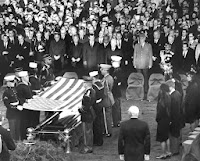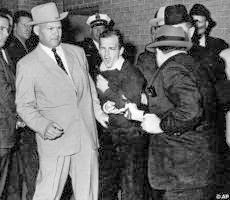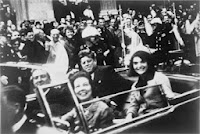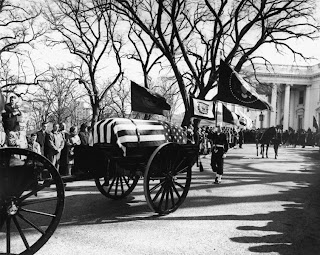Of all the 1,264 games played in University of Michigan football history,
the single most controversial contest ever played came in 1973 between the two
schools involved is what has been termed the “greatest rivalry in sports.”
That year, on Nov. 24, under cloudy skies (bordering on a slight fog at
kickoff), the top-ranked Buckeyes met the fourth-ranked Wolverines before an
NCAA record 105,223 fans at Michigan Stadium (not a single air-breathing
individual uttered the words, “Big House”).
What all was said and done, the scoreboard read 10-10 and both teams left
the stadium with the same expectations – Michigan would garner the Rose Bowl
invitation because Ohio State had gone the year before.
But nothing that took place starting shortly before 1 p.m. (EST) was ever
expected, anticipated or predicted. It tore apart the Big Ten Conference into
factions, caused resentment that lasted decades (and in some cases, has never
gone away) and major changes in conference policy towards post-season
competition.
Starting last Saturday night, the Big Ten Network began airing an hour-long
documentary, “Tiebreaker,” about those events and their aftermath. And while
what was presented could be seen by the viewership, it is doubtful most of them
were alive to have known the entire impact of that weekend in 1973.
Some of us do; we were there and participated in the unfolding of the
story, which would have a lasting impact over the next 40 years.
I was an assistant sports editor for The Michigan Daily, the University
of Michigan’s award-winning student newspaper, and sat in seat A17 among the
other area, regional and national reporters of the day. I was part of the game
coverage, post-game coverage and follow-up reporting which lasted well into
1974.
It was the most unique weekend of football and news in my tenure at The
Daily; it was filled with events and people you simply do NOT ever,
EVER forget. This is a telling of that entire story.
Different era, different
game
The underlying theme of “Tiebreaker” seems to suggest that college campuses
were boiling cauldrons of rebellion and protest – notably over Vietnam. And
while the Diag, at the heart of the Ann Arbor campus, always found protesters,
loud “discussions” and someone distributing flyers about some film, speech,
lecture or group session about the war, most of that collective student
involvement had, for the most part, dissipated into other pressing issues
(civil rights, women’s rights, students’ rights).
There were plenty of factions seeking justice for this and that, but come
Saturday afternoons, it was Wolverine football that united thousands of people
– young and old – to converge on the “house that (Fielding H.) Yost built.”
There was NO Wolverine Nation yet, but there was a hell of a party each home
game – EXCEPT for one encounter (Ohio State). Then it got serious.
College football was also a completely different sport in 1973. The
traditional powers dominated the polling landscape – the Associated Press
consisted on media members, mostly print, and the United Press International
rankings were based on votes of various coaches; they two seldom agreed.
 In the decade from 1969-78, when Woody Hayes coached Ohio State and his
protégé, Glenn “Bo” Schembechler led Michigan, every encounter was for the same
purpose – the Big Ten championship. In some of those years, national titles
were on the line, and, as was the case in 1969, a national crown was denied.
In the decade from 1969-78, when Woody Hayes coached Ohio State and his
protégé, Glenn “Bo” Schembechler led Michigan, every encounter was for the same
purpose – the Big Ten championship. In some of those years, national titles
were on the line, and, as was the case in 1969, a national crown was denied.
One only network – ABC – showed college football and teams did NOT appear
every week (Jefferson Pilot sponsored a regional network for the SEC and ACC,
but nothing coast-to-coast). The rule limited any school to just two national
appearances and one regional showing; many contests of major interest went by
the wayside, except for radio coverage (Notre Dame possessed a national
network, and the Southwest Conference had its Humble Oil/Esso Radio Network
where each school could be heard on some station in every major market – Dallas-Fort
Worth, Houston, Austin, San Antonio, El Paso, Waco, Midland-Odessa,
Lubbock-Amarillo, Corpus Christi).
Games almost never ran close to a three-hour window. The ’73 Michigan-Ohio
State game, with commercial stoppages and halftime, lasted all of 2 hours, 23
minutes! It fit perfectly into a crisp autumn southern Michigan afternoon.
The student body was a different breed, as well. Like an old fashioned ant
farm, students walked from State Street toward the stadium, armed with green
bottles of Ripple, Boone’s Farm or Annie Greensprings in hand. And around the
end of the third quarter, long lines of green glass could be seen snaking up
each aisle to the top of Michigan Stadium. When the crowd departed and the
cleanup crews began their duties, a tidy collection of empty bottles would encircle
the entire top row – recycling before it became vogue.
 In the press box, you cannot imagine how it went prior to any level of
ancient technology (to those of us today). There were no computers (not even
pocket TI calculators) and no copy machines. All game statistics were done by
hand, with pencil, in a huge ledger (provided by the NCAA), twice the length of
two 8x14 legal pads.
In the press box, you cannot imagine how it went prior to any level of
ancient technology (to those of us today). There were no computers (not even
pocket TI calculators) and no copy machines. All game statistics were done by
hand, with pencil, in a huge ledger (provided by the NCAA), twice the length of
two 8x14 legal pads.
Someone was assigned as “stat runner” and distributed updated official
numbers during timeouts, again handwritten and compiled. Play-by-play was
hand-typed (using an IBM Selectric typewriter if you wanted fancy-looking
sheets, or a reliable Underwood/Olivetti manual typewriter as was the case at
U-M in the mid-1970s).
And all of it was “copied” by way of a stencil mimeograph machine – with
one of the most distinctive odors associated with that process. To transmit
final game stats to the NCAA headquarters (in Shawnee Mission, Kan.), it was
done via a Xerox telecopier, which sent info through a machine in which one
page was inserted into a cylinder and used the phone signal to spin out the
image one line at a time. It resembled the tracks on a vinyl album and took as
much as two minutes to send a single page. If you had 15 pages (included
play-by-play), it could take anywhere from 30 minutes to an hour.
There were no video tape recorders – everything was done on film. In fact,
for coaches to view action from the first half, a cameraman was assigned a spot
on the press box roof, filming in black and white. After 10 minutes of action,
that film was sent to a portable dark room for development and then taken to
the Michigan locker room for use at halftime.
The entire second level of the press box was dedicated to the numerous
radio stations on the air. Before schools moved to singular radio networks, as
many as six local (Ann Arbor) stations aired the game live (including WCBN on
campus, WUOM, the NRP station, WAAM, WPAG, featuring Bob Ufer, and also WWJ in
Detroit). Ohio State brought its own gaggle of broadcasts, making for a packed
floor and plenty of doors to open with stat sheets.
When ABC came to town, those folks had to climb one additional level to the
roof (photographers level), where a wooden shack became telecast central. It
was cold, drafty and small portable heaters seldom did the job come November.
The game time temperature was 50 degrees and announcer Chris Schenkel and
analyst Duffy Daugherty (the former Michigan State coach) both bundled up to
the hilt.
And yet another difference came on ABC, which employed coaches (past and
present) and athletic directors – not former players – to sit second chair. In
the case of Daugherty, it made for awkward moments because he had just retired
as Michigan State’s head coach the previous fall. While Duffy was rivals with
Michigan for 18 seasons, he had great respect for Schembechler.
The buildup
Both teams were highly-ranked – Ohio State at number 1 in both polls (AP
and UPI) and Michigan at number 4. Both teams were, in fact, mirror images of
each other, as were the head coaches; both stressed stone-wall defenses and
offenses that believed firmly in the “three yards and a cloud of dust”
philosophy.
 Michigan’s one advantage was its passing game in the person of junior
Dennis Franklin, the pride of Massillon, Ohio. Despite Schembechler’s attitude
that when one throws the ball, “three things can happen and two of them are
bad,” the Wolverines had a better set of receivers, especially in tailback Gil
Chapman, a speedster from New Jersey, and 6-5 tight end Paul Seal from Detroit.
Michigan’s one advantage was its passing game in the person of junior
Dennis Franklin, the pride of Massillon, Ohio. Despite Schembechler’s attitude
that when one throws the ball, “three things can happen and two of them are
bad,” the Wolverines had a better set of receivers, especially in tailback Gil
Chapman, a speedster from New Jersey, and 6-5 tight end Paul Seal from Detroit.
But in his system, Bo primarily used a slotback (in 1973, it was Clint
Haslerig) as a downfield blocker. That year, his leading rusher was his
fullback, big Ed Shuttlesworth, an equally adept blocker for either Chapman or
backups Chuck Heater and Gordon Bell.
In the 1973 season, the top five rushers for Michigan gained a combined
2,753 yards and scored 31 touchdowns. Yet no player in that quintet gained more
than 745 yards (Shuttlesworth); everything in Bo’s system was balanced and
ground-oriented.
In Columbus, Hayes had a dream backfield with sophomore Archie Griffin (who
would be the only consecutive Heisman Trophy winner in 1974 and 1975, but was
the Big Ten Offensive Player of the Year in 1973) and freshman fullback Pete
Johnson, who, at 265 pounds, was still much stronger than most opposing
tacklers.
The Buckeye quarterback was sophomore Cornelius Greene, who was an expert
at running the power-option I, but who had perhaps the weakest throwing arm in
the conference.
The banner incident
Ohio State exited first out of the narrow tunnel from the locker rooms on
the east side of the stadium (there was no way back in the day two teams, like
happens in soccer, could even stand side-by-side). The locker room doors were a
12-foot putt apart and there was no place for media to go to obtain quotes from
coaches or players.
In fact, the visitors’ room had the shower entrance just inches from an
open door to the general public that followed the departing teams from the
gridiron.
 As the Buckeyes ran onto the Tartan turf, they made a beeline to the M Club
“Go Blue” banner (part of UM football since the early 60s) and swarmed it in an
attempt to rip, or tear, it down. The crowd became incensed when watching it,
adding fuel to an already raging inferno.
As the Buckeyes ran onto the Tartan turf, they made a beeline to the M Club
“Go Blue” banner (part of UM football since the early 60s) and swarmed it in an
attempt to rip, or tear, it down. The crowd became incensed when watching it,
adding fuel to an already raging inferno.
However, like the defenses on the day, it bent but never broke, allowing
the Wolverines to continue what has become something of a traditional- seeing
each Michigan player touch the banner prior to the start of any game.
But it didn’t stop legendary radio announcer Bob Ufer from going half-batty
from his press box perch.
“There isn’t a Michigan man who wouldn’t want to go out and scalp those
Buckeyes right now,” Ufer shouted. “They have the audacity – the unmitigated
gall – to tear down the coveted Michigan ‘M.’”
The game
It was a game of two halves; more accurately, it was a contest of three quarters
versus one dominant 15-minute section by Ohio State in the second stanza.
The first quarter was scoreless as both defenses dominated the action.
Despite running more plays than OSU, Michigan never got deeper than the Ohio 49
as the teams exchanged five punts.
Ohio State struck first, marching from its 20 to the Wolverine 14 before
Blair Conway booted a 31-yard field goal for the 3-0 lead.
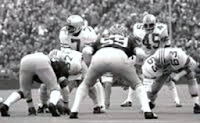 After more punts and complete lack of field position on either side, the
Buckeyes took possession at their 40 late in the first half. Griffin then took
over and with runs (often spectacular as he spun and stepped his way through
the U-M defense) of 6, 7, 7 and 12 yards. After a 9-yard gain to the Michigan
5, Johnson just bulled his way through center and into the end zone for a 10-0
halftime advantage.
After more punts and complete lack of field position on either side, the
Buckeyes took possession at their 40 late in the first half. Griffin then took
over and with runs (often spectacular as he spun and stepped his way through
the U-M defense) of 6, 7, 7 and 12 yards. After a 9-yard gain to the Michigan
5, Johnson just bulled his way through center and into the end zone for a 10-0
halftime advantage.
Michigan took the third quarter kickoff with more determination and purpose
as Shuttlesworth kept poking small holes in the OSU defense for what looked
like “5 yards and a cloud of dust” approach. Michigan’s longest run of the day
was 12 yards (by Chapman) while Shuttlesworth’s best rush was just 10 yards.
Yet he managed to finish with 116 yards on 27 carries.
However, the drive was stopped when Franklin’s pass into the end zone for
sophomore reserve end Keith Johnson was intercepted by Neal Colzie.
Towards the end of the quarter, Michigan began its scoring march from the
33, running 13 plays (nine of which were short Shuttlesworth burst) to the OSU
11. Placekicker Mike Lantry nailed a 30-yarder to narrow the deficit to 7.
Two of Ohio State’s major problems all game long were the complete absence
of a passing game and its punting woes. Because of a thumb injury suffered in
the previous game, Greene could not grip the football well enough to throw it.
Until the very end, Woody would not call for a single pass play.
But punting the ball was more of a calamity; two OSU punters (including
future All-American Tom Skladany) combined for only 220 yards on nine boots – a
woeful 31.4 yard average. And one of the poorest efforts was a 20-yarder that
was gobbled up by defensive tackle Dave Gallagher at the Ohio 46. However,
Michigan was penalized five yards for illegal procedure after safety Dave Brown
had signaled for a fair catch early in the process; he was actually expecting
the ball to get near him.
So, at the UM 49, Franklin engineered the game-tying touchdown drive,
highlighted by a 27-yard gain to Seal, who spun past two defenders and carried
another to the OSU 19.
 Three Shuttlesworth runs left Michigan with a fourth-down play at the 10,
and just mere inches to go for a first down. Everyone in attendance knew it
would be a quarterback sneak ... except for Schembechler and Franklin.
Three Shuttlesworth runs left Michigan with a fourth-down play at the 10,
and just mere inches to go for a first down. Everyone in attendance knew it
would be a quarterback sneak ... except for Schembechler and Franklin.
Taking the center snap, Franklin ran to his right and suddenly turned up
field (on the perfect option read), split two defenders, including Colzie (one
of the best secondary people on Buckeye history) and ran untouched into the end
zone. The image of him high-stepping well after he crossed the goal line, with
the football hoisted into the air, remains one of the two or three iconic
moments in Wolverine history.
As clearly shown on “Tiebreaker,” Schembechler’s reaction was not one of
jubilation, but more of an “I knew it would work” visage as he just nodded his
head in an affirmative fashion.
 Lantry’s kick tied the game and there was no doubt where every ounce of
momentum resided.
Lantry’s kick tied the game and there was no doubt where every ounce of
momentum resided.
Ohio State slowly drove down the field on the next series, but was stopped
at the U-M 44, forcing another short (32 yards) punt.
With less than four minutes to play, Franklin and company took over. He
sandwiched two 14-yard completions to Haselrig with a 6-yard loss in between.
The key play, as it turned out, was an 8-yard pass completion from Franklin
to Shuttlesworth with 2:23 left in the game. After he let go of the pigskin,
Franklin was drilled from the blind side by end Van Ness DeCree, sending the
quarterback to the turf in pain.
After a few anxious moments, Franklin was escorted off with head trainer
hold his right arm in place, obviously done for the afternoon.
Three more running plays left Michigan short of a first down at the Ohio
41. Lantry came out to attempt a school-record 58-yard field goal with 61
seconds left on the clock.
The kick was long enough and strong enough, but at the last second, drifted
to the left, just inches from the goal post.
Hayes, knowing there was not enough time to run the ball and get into any
kind of field goal position for Conway, called on reserve quarterback Greg Hare
to throw the Buckeye’s’ first pass of the contest.
But responding to a Wolverine pass rush, Hare threw up a pass off his wrong
foot, and it floated short of the intended receiver and into the arms of
Wolverine Tom Drake at the OSU 40. A 7-yard return gave U-M possession at the
33 with less than a minute to play.
 After a 6-yard run and an incomplete pass, Michigan (with no timeouts to
attempt a third-down play) decided to go for the win with Lantry and a 44-yard
field goal. But this time, it sliced wide right (perhaps because Ohio State
linebacker Randy Gradishar distracted Lantry by trying to block the kick by
leaping upwards on the back of a teammate, and falling into the line before the
ball was actually struck).
After a 6-yard run and an incomplete pass, Michigan (with no timeouts to
attempt a third-down play) decided to go for the win with Lantry and a 44-yard
field goal. But this time, it sliced wide right (perhaps because Ohio State
linebacker Randy Gradishar distracted Lantry by trying to block the kick by
leaping upwards on the back of a teammate, and falling into the line before the
ball was actually struck).
Three more incomplete passes by Hare ran out the clock and the “frozen in
time” moment became the image of the scoreboard showing a 10-10 tie.
For the game, Michigan had more yards in total offense (303-234), more
first down (16-9) and more plays (68-53), especially in the second half
(39-24).
The star-crossed kicker
In many ways, the 1973 game (and weekend) reflected the story of the Michigan
kicker, Lantry, whose story entering the game was as compelling as any in prior
Michigan football history.
A native of Oxford, Mich., Lantry had enlisted in the U.S.
Army immediately out of high school, during the height of the Vietnam War. He stationed
in Vietnam for one year (of his three-year service) and saw actual combat
action.
“For a full year, my parents agonized, hoping they wouldn’t get the call
that so many other parents received,” he reflected some years later.
Self-described himself as “a proud Vietnam veteran,” Lantry was still a
football player; he enrolled at Michigan in 1971 as a 23-year-old freshman –
married with one child (unless the normal age of freshmen at 18 or 19). He
walked on to the team and became the squad’s varsity placekicker in 1972.
In September of 1973, Lantry set the school record for longest field goal
twice – in the same quarter of the game versus Stanford with a 50-yard boot to
begin the second quarter and then a 51-yarder at the end of the first half. It
would be a standard that lasted until 1984 when Bob Bergeron kicked a 52-yard
field goal.
In all, he performed his duties in 33 games and was one of the last
successful straight-on kickers in U-M history. His personal history made his
one of the leaders of the U-M squad and was well-respected within the Ann Arbor
community. In addition to his football duties, Lantry also competed as a shot
putter in track for Coach Jack Harvey, earning three varsity
letters.
Lantry was selected by The Football News
as a first-team All-American in 1973, and he graduated in 1975 with a degree in
education.
But … out of those 33 games, his legacy surrounds just two contests – the
1973 and 1974 encounters with the Buckeyes. And because of the outcome of the
1974, Lantry actually helped change NCAA rules concerning field goals.
In the 1974 game (played in Columbus), Michigan’s defense rose to the
occasion all game long, holding a vaunted Buckeye offense without a touchdown,
but trailed 12-10, thanks to four goals by Tom Klaban, (one of many diminutive
kickers that would make life miserable for Wolverine fans).
In an almost reverse carbon-copy of the year before, it was Michigan
leaping to a 10-0 first-half lead on a 42-yard pass from Franklin to Chapman on
U-M first possession and Lantry’s 37-yard field goal with 4:57 remaining in the
opening stanza.
But Klaban scored the next 12 points on field goals of 47, 25, 43 and 45
yards.
In a game where there was no statistical advantage (each team rushed for
the same number of yards – 195) and two turnovers apiece stopped potential
scoring drives.
In the waning moments of the contest, Michigan got the ball at its 47 and
Franklin promptly connected with end Jim Smith over the middle for 21 yards and
two carries by halfback Rob Lytle for 16 yards moved the ball to the Ohio 16.
With just 18 seconds left, on to the field came Lantry, who had already
missed long attempts and was not having a stellar season (missing 11 of 16
field goal tries going into Columbus). After his made kick in the first
quarter, Lantry was short on kicks of 58 and 51 yards, booting into a 25 mph
wind.
So, with an undefeated 10-0 season on the line, the 33-yard attempt would
come from the right hash mark into the closed (student) end of the
horseshoe-shaped stadium.
Lantry had more than enough leg as the ball sailed high (like a lofted
wedge) into the Ohio air; as it was spinning to the left, the ball actually
sailed OVER the goal posts and was declared no good.
Buckeye fans then swarmed the field and ripped the goal posts off their
mountings. In the middle of all that chaos, Lantry stood among the mob, picked
up his kicking tee (because that was his responsibility as kicker), turned
slowly and walked a very isolated, lonely walk to the U-M bench.
On national television, ABC’s Keith Jackson described the scene thusly: “And
there is Mike Lantry, walking disconsolately toward the sideline.”
Bill Jauss, of the Chicago Tribune wrote, “Mike Lantry served
in the Vietnam War and he had reason to believe the worst was over – until
Saturday.”
Instead of derision for missing game-winning field goals against the
school’s mated despised rival, Lantry received thousands of fan letters,
expressing compassion, sympathy and encouragement.
“I hate to see that happen to a kid like that because he served his country
in Vietnam, but if it had to happen, I’m glad it happened against us,” said
Hayes, always remembering his role in the Ten-Year War with Bo.
“I guess the biggest surprise is the way people have acted; they’re
suffering with me,” Lantry said in a later press conference. “They’ve been more
than kind. I wish there was a way I could thank them all.”
In a 2004 interview, Lantry said, “I was numb. That was the final play of
my college career right there. Everything you worked for, those glorious years
of competition, my teammates. ... If we had won that game, we would have played
in the Rose Bowl; we could have shot to the top of the AP and UPI rankings. Who
knows? That was like the World Series: bases loaded, bottom of the ninth, two
outs, a 3–2 count. It was on my foot, but it didn’t happen.”
In 1974, the NCAA (and NFL) narrowed the hash mark distance two seasons
before (making it a lot easier to kick from easier angles). But the height of
the goal posts was lengthened, to prevent exactly what happened at the end of
the UM-OSU affair. To this day, no recorded replay can definitely show for sure
whether the ball sailed OVER, AWAY or INSIDE the plane of the uprights (not
unlike an umpire’s strike zone).
Oh, yes, Lantry’s kicking tee was banned from NCAA competition in 1989.
Post-game
When the final gun sounded, to a man, the Michigan coaches and players
believed they were the better team despite the tie and had proven it on the
field; by virtue of the Buckeyes having gone the prior January 1 to Pasadena,
it was Michigan’s turn.
Even Ohio State coach Woody Hayes, in post-game comment, admitted his
team wouldn’t be the one going to the Rose Bowl.
Had there been sports talk radio in 1973, the conversation would have
centered on Franklin’s medical condition, by then diagnosed as a broken
collarbone, as well as the Wolverines’ domination in the second half.
As long as The Big Ten was in existence, there was a policy whereby only
the conference champion would go to a bowl; and the Rose Bowl was a contractual
obligation with the Pac-8 since after World War II. That matchup made it the
marquee (and financially richest) matchup among the four New Year’s Day “commodity”
games (Rose, Cotton, Sugar, Orange).
There was also a “no-repeat” rule until 1971, and if it had still been in
effect, Michigan would have automatically gone to the Rose Bowl, even if it had
lost to the Buckeyes.
But the abolition of that rule meant the decision rested with the Big Ten’s
athletic directors. And the vote would be held by telephone conferencing. That
call was held out of the conference’s offices in Chicago early Sunday morning.
The vote
I was living in a house on Sylvan Street, just three blocks from the
athletic department offices on South State Street, with members of the U-M swim
team. It was a quiet Sunday morning with most of the housemates still in deep
slumber, despite the clocks approaching 11 a.m.
Then the phone rang in the kitchen and I was the one answering it. My
student newspaper counterpart from Ohio State, Jack Torry of the Lantern,
was on the line asking a simple question, “So what do you think of what
happened?”
“What are you talking about?” I responded.
“Oh my God, you don’t know, do you?” he said. “God, I hate to be the one
you hear this from … they voted Ohio State to go to the Rose Bowl, not you
guys.”
“What in the hell is THEY?” I exclaimed.
“The conference athletic directors; happened this morning. A 6-4 vote,”
Jack added. “Damn, I’m sorry to be the one. You need to jump on this.”
I thanked him for his candor and the heads-up and said I held nothing
against him, or even Ohio State. I did add, “We’ve got fish to fry and heads to
chop.”
And off I went calling as many of my fellow Daily mates as possible.
During that session, our sports editor, Dan Borus, got through to announce a
staff meeting at the paper’s office right after lunch. It was a solemn, unhappy
crew that gathered at 420 Maynard to map out how the story would be covered.
The vote went 6-4 against Michigan (although the head count has never been
revealed and the actual tally has been disputed, as shown on “Tiebreaker”); it
brought forth a phrase forever lodged in the throats of every Wolverine fan – “the
most representative team” – was being sent to Pasadena.
 Schembechler, as expected, was openly furious, calling the decision “an
embarrassment to the Big Ten Conference” and claiming “petty jealousies” were at
play.
Schembechler, as expected, was openly furious, calling the decision “an
embarrassment to the Big Ten Conference” and claiming “petty jealousies” were at
play.
In three years (1972-74), Michigan went 30-2-1 games and sat home each of
those subsequent Januarys. It wasn’t until 1975 when the conference finally saw
the light and permitted expansion of Big Ten representation. So when Michigan
played Ohio State at home in 1975 (losing 21-14), it was already known that the
game’s loser would still play Jan. 1 in the Miami-based Orange Bowl against
Oklahoma.
The Big Ten office did not, and would not, release the actual vote, but
according to the reporting of Curt Sylvester in the Detroit Free Press,
Ohio State was supported by Illinois, Michigan State, Wisconsin, Purdue and
Northwestern. Michigan had the backing of Indiana, Iowa and Minnesota.
To add salt to the wound, if the vote had been tied at 5-5, Michigan would
have been awarded the Rose Bowl berth.
There were more rumors swirling around this story than anything modern-day
Twitter could create. Four men in that group had direct ties to Michigan –
either as former players or coaches. It was said (without any basis) Michigan State University voted for Ohio State
as retaliation for Michigan’s “no” vote in 1949 against admitting MSU to the
Big Ten (in favor of Pitt). Spartan athletic director Bert Smith, was a
Michigan graduate (a former hockey and baseball player), but diploma-loyalty
meant nothing in this case; rivalries and grudges seemed to be the order of the
day.
Schembechler said he had spoken with Illinois football coach Bob Blackman, who claimed,
according to Bo, his athletic director (Cecil Coleman) was going to
vote for Michigan. Yet, it was revealed later that Coleman sided with the
Buckeyes.
 Schembechler held particular bitterness towards Wisconsin, whose athletic
director, “Elroy “Crazylegs” Hirsch, was a pre-World War II star with the
Wolverines. Bo always blamed him for shifting to Ohio State, thus avoiding the
5-5 tie in U-M’s favor.
Schembechler held particular bitterness towards Wisconsin, whose athletic
director, “Elroy “Crazylegs” Hirsch, was a pre-World War II star with the
Wolverines. Bo always blamed him for shifting to Ohio State, thus avoiding the
5-5 tie in U-M’s favor.
Just how much then-Big Ten Commissioner Wayne Duke
influenced the outcome will never be known. Duke was vehement in his denial of
having his fingerprints on the outcome, stating the athletic directors merely
followed the procedure that had been put into places just two years earlier.
“I am only the messenger,” he responded.
Another controversy (as revealed in the documentary) was the actual “vote”
itself – whether the 10 athletic directors met in person, or if it was a
teleconference over the phone. Bump Elliot, then at Iowa and the man
Schembechler replaced at Michigan, said it was done over the phone.
One storyline had Smith voting for neither school, placing his tally with
his Spartans (although that didn’t seem to be an honest option). In a tape of a
speech Smith made days later, he unapologetically said his vote went to Ohio
State – pure and simple.
No one knows exactly how the vote was decided, and in what fashion, except
Duke and the Big Ten lawyer; and neither man was saying a damn thing (on the
record) to the cameras – even 40 years later (invoking lawyer-client privilege
to shield the conference).
So on Jan. 1, 1974, Ohio State defeated Southern Cal 42-21 to win the Rose Bowl.
And all over Michigan, the Nielsen ratings would have showed one of the lowest
viewerships in TV history for a New Year’s Day tradition.
In his 1989 autobiography, simply titled “Bo” (written with Mitch Albom),
Schembechler believed the Big Ten was “nervous” because it had lost the prior
four Rose Bowls (two losses by U-M in 1970, 1972, and two by OSU in 1971,
1973), and because of Franklin’s injury, it was facing a fifth setback. But Bo
always rejected that excuse, saying it was a reward to go to Pasadena and his
squad had more than earned it.
The vote was also a slap in the face to players like fifth-year senior
Larry Cipa, who had been a starter in 1971 (sharing the duties with Tom Slade).
The Big Ten told the team, and Cipa in particular, “you aren’t good enough to
play in the Rose Bowl;” that is what burned deepest within Schembechler.
Changes finally came two years later. Among them was the abolishment of the
“Rose Bowl or No Bowl” edict, allowing more than one conference team to accept
invitations to other bowls.
Another change, also in 1975, was the elimination of the athletic
directors’ vote in the event of a conference championship tie; the new rule was
the old understanding – the team which had gone the longest without appearing
in the Rose Bowl would go to Pasadena. Schembechler lobbied hard for that
reform, stating the athletic directors weren’t qualified to decide which team
would “better represent” the conference in the Rose Bowl.
Of course, Ohio State did not go totally unscathed; the tie denied the
Buckeyes any chance at a national championship. Alabama moved into first place
in both polls, and finished the regular season at 11-0 to earn the national
title in the UPI coaches poll (which did not have a
post-bowl season vote at the time).
The reaction
 “Yeah,
I was ready for the team meeting on Sunday to go over the travel plans,” said
Rich Stuck, who was on the Daily sports staff and was one of
the student equipment managers for U-M football.
“Yeah,
I was ready for the team meeting on Sunday to go over the travel plans,” said
Rich Stuck, who was on the Daily sports staff and was one of
the student equipment managers for U-M football.
Everyone in the football facility had the
same thoughts; how much they would enjoy Pasadena compared to the expected snow
and ice at New Year’s in the Midwest.
A team meeting had been called for 2 p.m. and
it was a difficult task for Schembechler to face his charges. After he spoke to
them, the doors were opened and players began to exit; the Daily had been alerted to
the meeting by Rich and we waited in the hallway until the proceedings ended.
My assignment was two-fold – get the players
reactions to the decision and their post-game thoughts about which side was the
better team. Expectedly, each Wolverine, to a man, took the new hard. Forty
years later, as shown in the documentary, that pain was forever seared into the
minds and souls of those who competed and felt cheated.
“We got screwed,” Franklin succinctly told
the cameras. “Regardless of my injury, we deserved to go.”
And on Jan. 1, outside his home in Massillon,
photographers took pictures of Franklin throwing snowballs and a football; he
certainly could have played.
‘That son-of-a-bitch’
Schembechler
ALWAYS credited Hirsch with being THE deciding vote. And one day, I learned his
feelings the hard way.
In 1975, Bo began to co-host a weekly
half-hour show on WXYZ-TV, called “Michigan Moving,” which had him comment on
highlights from the day before, preview the next opponent and introduce
features from the station’s sports department and from the U-M Sports
Information Department.
As part of my duties was the selection and
collection of old film on past Wolverine standouts, and experimenting with
current highlight film to coordinate with background music; meaning I was doing
a music video by playing a 45 rpm record on a portable “Victorla” and timing
what I was seeing through a tiny viewfinder attached to a crude, ancient
editing machine.
Using a bottle of glue and a tune in my head,
I created something the professional editors at WXYZ could fix for airplay. My
best effort was a two-minute video of halfback Gordon Bell (one of the best
runners in U-M history who perfected the spin move against opposing defenders).
In the background was the Dave Clark Five hit, “Catch Me If You Can.”
 Earlier in the season, when cleaning out a
dank, dark storeroom in the basement of the State Street office, I came across
a canister of 70 mm movie film or unknown origin. We went to the Michigan
Theater to unearth our discovery to find a couple of half-hour highlight shows
from the 50s (featuring All-American Ron Kramer) and one showing exploits
(pre-World War II) of Michigan’s best players, including Elroy “Crazylegs”
Hirsch.
Earlier in the season, when cleaning out a
dank, dark storeroom in the basement of the State Street office, I came across
a canister of 70 mm movie film or unknown origin. We went to the Michigan
Theater to unearth our discovery to find a couple of half-hour highlight shows
from the 50s (featuring All-American Ron Kramer) and one showing exploits
(pre-World War II) of Michigan’s best players, including Elroy “Crazylegs”
Hirsch.
“Perfect,” I thought. “A classic player and
vintage film, perhaps never-seen-before.”
I could NOT have been more wrong in my life!
When I informed Bo of the upcoming segment, he blew a gasket, yanked me by the
lapels of my winter coat, and me (when I was no small humanoid) off the ground and
against the wall of the football training room.
“It was THAT son-of-a-bitch who kept us out
of the Rose Bowl,” he said, visibly seething. “He'll NEVER appear on my show!
EVER!”
He then immediately apologized but it was
obvious how badly he had been hurt. I told him I didn’t know Hirsch was THE
vote and he understood. I know he took that feeling to his grave!
Bitter to the end
The reason Bo remained particularly bitter about the 1973 team, which never
lost a game, but never rewarded with any kind of bowl assignment, was the place
those players held in Schembechler’s heart. The Class of 1973 (the seniors)
were part of his very first recruiting class for the Maize and Blue and as
eligible Wolverines (freshmen could not play in 1970), those men lost just two
games in three seasons (one being the Rose Bowl of 1972 and the 1972 Ohio State
game).
Many of them were recruited from places close to Bo’s boyhood home in
Barberton, Ohio – where he was revered as a player and coach.
He remained angry at the vote until his passing in 2006, just 34 hours
before the “Game of the Century” between the numbers 1-2 ranked teams in
America – Ohio State and Michigan. Current Michigan athletic director Dave
Brandon (who was Domino’s Pizza CEO at the time) had dinner with Schembechler
the night before Bo suffer his fatal attack (at the WXYZ-TV studios in Detroit)
the next morning. According to reports, the coach, who symbolized all that was
good about being a Michigan man, said it was the worst day of his life.
The BTN documentary
“Tiebreaker” is a well-executed documentary, especially in how the former
combatants returned for a friendly meal and exchanged probably never heard in
public before.
It was a moving moment when Greene praised Franklin for his courage as the
conference’s first black quarterback (although Sandy Stephens at Minnesota and
Jimmy Raye at Michigan State preceded Franklin), admitting Franklin was a “role
model” and “hero” to the Buckeye QB. One could see how visibly moved Franklin
was at hearing such an admission for the first time.
And while it would have been nice to learn, 40 years later, what each man
had done with his life, where the journey had taken them, there is only SO much
information that can be squeezed into an hours’ worth of visuals.
 On a personal note, it was bittersweet for me to see former Michigan Sports
Information Director Will Perry, who was my boss in my student assistant days,
interviewed, perhaps just weeks before he passed away. He looked strong,
sounded strong and has strong recall of the facts surrounding the subject
matter.
On a personal note, it was bittersweet for me to see former Michigan Sports
Information Director Will Perry, who was my boss in my student assistant days,
interviewed, perhaps just weeks before he passed away. He looked strong,
sounded strong and has strong recall of the facts surrounding the subject
matter.
He was an old school SID, conducting his profession almost on a retail
basis – where each phone call to print or other media members had purpose and
solved situations.
Perry wrote a book in 1974 on Michigan football history, “The
Wolverines: A Story of Michigan Football,” for which I did a bunch of research.
Appropriately, the final chapters were all about the 1973 game, which almost
wrote themselves.
Epilogue
Until the 1997 Michigan team secured a national title with its win over
Washington State in the Rose Bowl, the only other undefeated squad belonged to
the 1992 Wolverine unit, which went an (unbelievable) 9-0-3 on the year –
opening with a tie at Notre Dame and finished with the sister-kisses against
Illinois and a 13-13 deadlock in Columbus.
U-M then defeated Washington 38-31 behind Elvis Grbac’s passing and Tyrone
Wheatley’s 235 yards rushing on 15 carries.
And no one said a word...
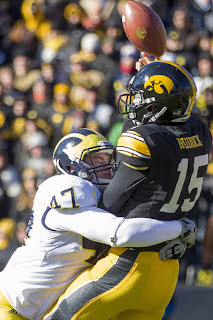.jpg) The
collapse ruined two of the best individual defensive performances by juniors Jake
Ryan (who should have been charged with terrorism for what he was doing to
Rudock and other Hawkeyes) and Frank Clark, who has blossomed into the best U-M
lineman out of the carousel of bodies used up front. But it was obviously a
case of a worn-out unit in the second half because the inability of the offense
to stay ON the field again proved to be lethal.
The
collapse ruined two of the best individual defensive performances by juniors Jake
Ryan (who should have been charged with terrorism for what he was doing to
Rudock and other Hawkeyes) and Frank Clark, who has blossomed into the best U-M
lineman out of the carousel of bodies used up front. But it was obviously a
case of a worn-out unit in the second half because the inability of the offense
to stay ON the field again proved to be lethal. Fans
would love an explanation as to how Michigan squandered a 14-point halftime
lead with such ease. Well, just look at the stats from the game (in this case
revealing plenty):
Fans
would love an explanation as to how Michigan squandered a 14-point halftime
lead with such ease. Well, just look at the stats from the game (in this case
revealing plenty):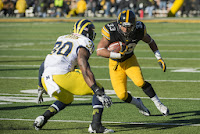 I
know it’s easy (too easy) to blame everything on a youthful offensive line that
keeps getting juggled like Yahtzee dice. But on this vehicle, everything is
malfunctioning and it gets a tad old to see the same thing being played out
each down, each series … each game.
I
know it’s easy (too easy) to blame everything on a youthful offensive line that
keeps getting juggled like Yahtzee dice. But on this vehicle, everything is
malfunctioning and it gets a tad old to see the same thing being played out
each down, each series … each game.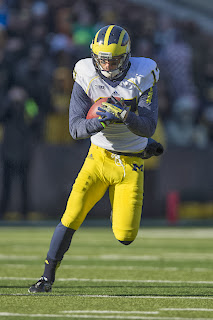 Sorry
to state this, but it is more apparent each week: Gardner has plenty of talent,
but he is no better than the lowest three quarterbacks in the conference (based
on actual performance). Purdue, Illinois and Michigan have gotten the worst
results from its “leader” than anyone in the Big 10.
Sorry
to state this, but it is more apparent each week: Gardner has plenty of talent,
but he is no better than the lowest three quarterbacks in the conference (based
on actual performance). Purdue, Illinois and Michigan have gotten the worst
results from its “leader” than anyone in the Big 10. In
the Iowa game, only two of the turnovers allowed the offense to take a snap; the
results were the 28-yard touchdown drive (a pass to TE A.J. Williams) and a
punt after losing a yard in four plays.
In
the Iowa game, only two of the turnovers allowed the offense to take a snap; the
results were the 28-yard touchdown drive (a pass to TE A.J. Williams) and a
punt after losing a yard in four plays.



